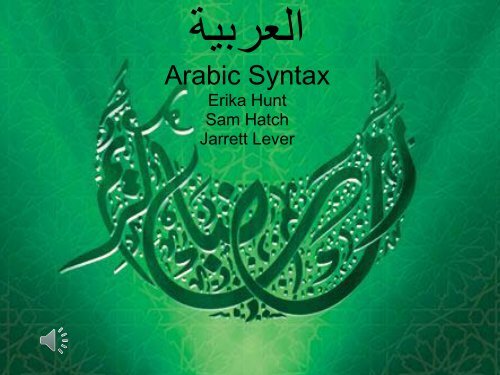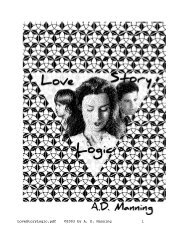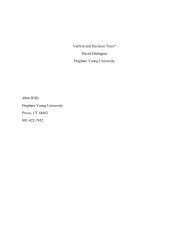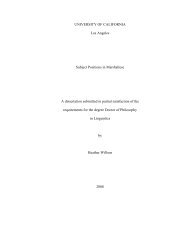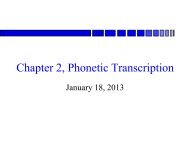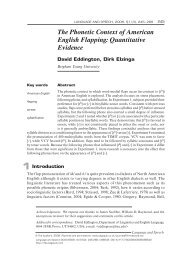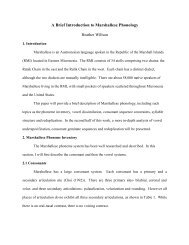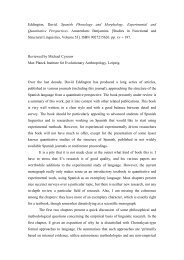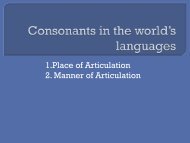Arabic Syntax - BYU Department of Linguistics and English Language
Arabic Syntax - BYU Department of Linguistics and English Language
Arabic Syntax - BYU Department of Linguistics and English Language
You also want an ePaper? Increase the reach of your titles
YUMPU automatically turns print PDFs into web optimized ePapers that Google loves.
العربية<br />
<strong>Arabic</strong> <strong>Syntax</strong><br />
Erika Hunt<br />
Sam Hatch<br />
Jarrett Lever
About <strong>Arabic</strong><br />
• 206,000,000 L1 speakers <strong>of</strong> all <strong>Arabic</strong> varieties (ethnologue)<br />
• We will discuss Modern St<strong>and</strong>ard <strong>Arabic</strong> (Fusah)<br />
• Some places that it's spoken: Middle East, North Africa. Also in Algeria, Bahrain,<br />
Chad, Comoros, Djibouti, Egypt, Eritrea, Iraq, Israel, Jordan, Kuwait, Lebanon,<br />
Libya, Morocco, Oman, Palestinian West Bank <strong>and</strong> Gaza, Qatar, Somalia, Sudan,<br />
Syria, Tanzania, Tunisia, United Arab Emirates, Yemen. (ethnologue)<br />
• Script reads right to left
Overview<br />
• Word Order VSO or not VSO…<br />
• Hierarchy <strong>of</strong> Projections<br />
• Basic Sentences<br />
• Negation<br />
• Interrogatives<br />
• ECM & Pro (not!)
VSO, or is it????<br />
• Case Marking allows virtually<br />
any word order<br />
• VSO <strong>and</strong> SVO most common<br />
• Most agree that <strong>Arabic</strong> is VSO<br />
• MSA (Fusah) mostly VSO<br />
• Egyptian mostly SVO<br />
zayd-un qabala amr-an (SVO)<br />
Zayd met Amr<br />
qabala zayd-un 'amr-an<br />
met Zayd Amr
Hierarchy <strong>of</strong> the DP<br />
DP>(Poss)>nP>NP<br />
with other postnominal modifiers such as (Numbers) <strong>and</strong><br />
(Quantifiers) possible as well
Hierarchy Continued<br />
FP > CP> AP> TP > (NEG) > vP > VP<br />
New Categories<br />
FP- is a functional projection (not CP) where an auxiliary can go<br />
AP- Aspect phrase
Verbless Sentence<br />
• In cases where the sentence is equational (ie.<br />
x is y) <strong>Arabic</strong> does not use a verb<br />
• 'ana taalib (I am a student)<br />
• Word order is always SO
Basic Sentence with a Verb<br />
6 Ways to Say Zayd met Amar (there are<br />
more)<br />
un: nominative<br />
• qabala zayd-un 'amr-an an: accusative<br />
• qabala amr-an zayd-un<br />
• zayd-un qabala amr-an<br />
• zayd-un amr-an qabala<br />
• amr-an qabala zayd-un<br />
• amr-an zayd-un qabala<br />
With case marking all word orders are grammatical<br />
in MSA
Negation<br />
A. laa ya-qra-u Zayd-un al-kitaab-a<br />
NegPresent IMPER-read 3sg.mas.-IND Zayd-NOM the-book-ACC<br />
“Zayd is not reading the book.”<br />
B. lam ya-qra-Ø Zayd-un al-kitaab-a<br />
NegPast IMPER-read 3sgmas-JUS Zayd-NOM the-book-ACC<br />
“Zayd did not read the book.”<br />
C. lan ya-qra-a Zayd-un al-kitaab-a<br />
NegFuture IMPER-read 3sgmas-SUB Zayd-NOM the-book-ACC<br />
“Zayd will not read the book."<br />
D. t-tullab-u laa ya- drus-uu-n<br />
the-students Neg 3-study-mp-ind<br />
"The students do not study"<br />
The negation particle laa in SA is tense-inflecting. Depending on the tense <strong>of</strong><br />
the sentence, it will surface as lam (for negation in the past), lan (for negation<br />
in the future), or laa, the elsewhere form
Negation Con. (in verbless sentences)<br />
A. maa Zayd-un fii-/al-dar-i<br />
Neg Zayd-NOM in-the-house-GEN<br />
“Zayd is not in the house.”<br />
b. laysa Zayd-un fii-/al-dar-i<br />
Neg3sg.mas. Zayd-NOM in-the-house-GEN<br />
“Zayd is not in the house.”<br />
c. *laa/lam/lan Zayd-un fii-/al-dar-i<br />
Neg Zayd-NOM in-the-house-GEN<br />
Laa, lam, <strong>and</strong> lan all carry tense information that is received from the verb <strong>of</strong> the<br />
sentence. If the sentence is verbless, maa or laysa is used.
Interrogatives: Wh-Questions<br />
• Wh-questions require a verb to follow the wh-element:<br />
o man 'akala at tuffahat-a<br />
o who ate(3sg Masc) the apple (acc)<br />
• However, embedded clauses in the question can follow<br />
whatever order they want, so long as a verb follows the wh<br />
o mada qalat<br />
muna ‘inna ‘ahmad-a ‘akala<br />
o what said(3sg fem) Mona that Ahmed-Acc ate (3 sg masc)<br />
• The wh-element moves up from comp-VP to spec-CP<br />
• Word order <strong>of</strong> embedded clauses shows that MSA is VSO<br />
o If <strong>Arabic</strong> is VSO, the wh-simply moves up the hierarchy from<br />
spec-CP to spec-CP without changing any word order<br />
o If <strong>Arabic</strong> is SVO, the wh- must move through each spec-CP <strong>and</strong><br />
then front the verb <strong>of</strong> the last clause it l<strong>and</strong>s in. Because the<br />
fronting does not apply to each clause, SVO is less logical than<br />
VSO
VSO<br />
Wh-sentence<br />
with<br />
embedded<br />
clause<br />
What did Mona say Ahmed<br />
ate?
Assignment <strong>of</strong> Case:<br />
CP & TP<br />
• CP <strong>and</strong> TP both assigning case to the “subject” DP <strong>of</strong> the<br />
clause<br />
• C <strong>and</strong> T with case features have to discharge them<br />
• The case feature that is explicitly realized is the case from<br />
the highest head in the tree.<br />
CP's case is realized on the "subject"<br />
TP's case is realized on the "subject"<br />
ʔaʕtaqidu ?anna l-walad-a fii l-bayt-i<br />
Believe.1.a. that the-child-ACC in the-house-GEN<br />
‘I believe that the child is in the house.’<br />
qultu ʔinnha-hu waSala l-ʔawlaad-u<br />
said.1.s. that-it arrived.3.m.s. the–children-NOM<br />
‘I said that the boys arrived’
A<br />
s<br />
o<br />
f<br />
s<br />
i<br />
g<br />
n<br />
C<br />
a<br />
s<br />
m e<br />
e :<br />
CP's Acc.Case is<br />
realized<br />
n<br />
t<br />
C<br />
&<br />
T<br />
TP's Nom.Case is realized
pro<br />
• verb w/ all <strong>of</strong> its inflection<br />
doesn't need a subject<br />
• Thus a lot <strong>of</strong> little pro in<br />
<strong>Arabic</strong><br />
• Called by some a "nullsubject<br />
language"
ECM<br />
• a "pseudo-ECM"<br />
o assigns accusative case to the embedded “subject”<br />
o yet there is a CP present<br />
o <strong>and</strong> the “verb” <strong>of</strong> the complementary phrase is not<br />
infinitival but is technically tensed*<br />
ʔaʕtaqidu ʔanna-hu ya-lʕabu<br />
Believe.1.s. that-him 3-playing<br />
‘I believe that he is playing’<br />
*though there may be no “independent temporal” interpreter <strong>of</strong> the action (see notes).
ECM continued<br />
ʔaʕtaqidu ʔanna-hu ya-lʕabu<br />
Believe.1.s. that-him 3-playing<br />
‘I believe that he is playing’
الأسئلة<br />
Questions?


